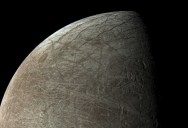Best Images of Europa in 20 Years Stir Prospect for Life Beyond Earth
by Ashley Dreiling
In September 2022, the Juno spacecraft returned images taken during a flyby from only 219 miles (352 kilometers) above the surface of Jupiter’s icy moon, Europa. The satellite flyby had two goals – move to a tighter orbit around Jupiter and study the moon’s characteristics to confirm the widely-held theory that it contains life outside of Earth.

Photo Source: NASA/JPL-Caltech/SwRI/MSSS/Kevin M. Gill
Juno’s images are the first taken since Galileo’s discoveries in 2000, after which plans were made for further exploration of Europa but never fully came to pass. The JunoCam provides higher resolution images – 1 kilometer (0.6 miles) per pixel – than those taken by Galileo, which are still being reprocessed using more current technology.
The first pic of #Europa in twenty years.
Courtesy of @NASAJuno, processed by yours truly.
Look at the detail along the terminator 😍 pic.twitter.com/15Qvu4Otoc
— Paul Byrne (@ThePlanetaryGuy) September 29, 2022
Equipped with gravity sensors, detectors of high-energy particles, and instruments that can see in the ultraviolet, radio, and microwave parts of the spectrum, Juno provided critical information about craters on the moon’s surface.
One was guessed to be quite new since it’s believed that the shifting ice in Europa’s ocean would quickly erode craters that would last for billions of years on other planets.

Photo Source: NASA/JPL-Caltech/SwRI/MSSS
Europa was largely ignored during most missions to Jupiter until Voyager 2 revealed the crust of ice over its internal ocean made it the smoothest object in The Milky Way. Plans began for the Europa Clipper, a spacecraft focused on this moon alone, while science fiction writers and astrobiologists began to consider life on Europa.
However, Galileo’s budget and other factors delayed the Clipper project. It is scheduled to launch in 2024 but will require two gravity assists from Mars and Earth to reach Jupiter by 2030.
Categories: SCI/TECH
Tags: · astrobiologists, astrobiology, craters, earth, Europa, Europa Clipper, flyby, gravity sensors, internal ocean, Juno spacecraft, JunoCam, jupiter, jupiter's moons, mars, microwave, moon, orbit, radio, satellite, The Galileo, The Milky Way, The Voyager 2, top, ultraviolet
Trending on TwistedSifter

Parents Emotionally Manipulated Grandparent Into Babysitting For 5 Days, So They Took The Kids To Disney Without The Parents



